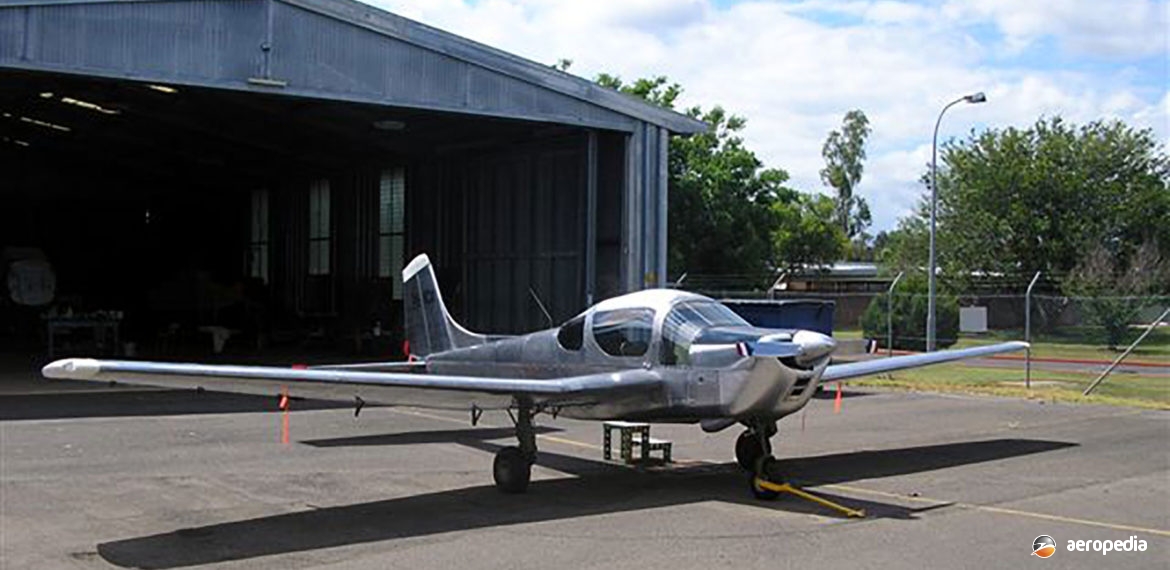Photograph:
The Southern Cross SC-1 prototype VH-SCA (c/n 1) at Oakey, QLD in 2007 after restoration (Museum of Army Aviation)
Country of origin:
Australia
Description:
Four-seat, mid-wing, cabin monoplane
Power Plant:
One 134 kw (180 hp) Lycoming O-360-A1A four-cylinder horizontally-opposed air-cooled engine
Specifications:
- Wingspan: 11.28 m (37 ft)
- Length: 6.89 m (22 ft 7 in)
- Height: 2.23 m (7 ft 4 in)
- Wing area: 15.9 m² (171 sq ft)
- Max speed: 286 km/h (178 mph)
- Max cruising speed: 257 km/h (160 mph)
- Economical cruising speed: 241 km/h (150 mph)
- Stalling speed: 80 km/h (50 mph)
- Service ceiling: 5,180 m (17,000 ft)
- Rate of climb at sea level: 332 m/min (1,090 ft/min)
- Take-off run: 55 m (179 ft)
- Take-off distance to 15 m (50 ft): 218 m (715 ft)
- Range with max payload, with auxiliary tank with normal allowances: 1,610 km (1,000 miles)
- Fuel capacity: 172 litres (38 Imp gals)
- Empty weight: 567 kg (1,250 lb)
- Loaded weight: 1,066 kg (2,350 lb)
History:
Southern Cross Aviation Ltd was formed in Toowoomba, QLD, in 1957 to explore the feasibility of designing and manufacturing a light aircraft in Australia to compete against the American imports of Cessna and Piper. Following a market survey, the decision was made to initially offer a four-seat cabin monoplane of all-metal structure. The aircraft was designed by Newton D Hodgekiss and Brian Wagner. Construction of a prototype, designated the SC-1, was commenced. The design was intended primarily for the private owner, but could be adapted for duties such as training, supply dropping, and agricultural work. Initially the aircraft was to be powered by a 108 kw (145 hp) Continental engine.
On 31 January 1958 Southern Cross Aviation Ltd was formed at Toowoomba to manage the project. The prototype (c/n 1), which carried the registration VH-SCA, was constructed by Toowoomba Foundry Pty Ltd, and was completed late in 1960. Initial test flights were conducted at Oakey, QLD, the first flight being made by Rodney J Trousdell on 6 February 1961. Testing revealed very good short take-off and handling capabilities. However, after 23 hours of testing it was revealed major costly alterations would need to be made to the design before it could enter full-scale production. With the economic climate as it was at the time the board of Toowoomba Foundry voted five to four against continuing with the project.
Considerable test flying was carried out, but a Certificate of Airworthiness was not issued, the allotted registration (VH-SCA) was not taken up, only being used as a call-sign during testing. The SC-1 faced the usual problems associated with developing and building aircraft in Australia, making its final flight on 1 June 1961 when it was ferried to Toowoomba where the aircraft was placed in storage, the engine being removed and sold with the propeller. The engineless airframe was later obtained by the Moorabbin Air Museum, VIC (as it then was) in 1970 and this important effort at producing a local four-seat aircraft was not placed on display at that time.
In 1988 the test pilot, Rodney J Trousdell, discovered the aircraft in storage at Moorabbin and suggested it be returned to Oakey. After lengthy negotiations, in late 2002 it was obtained on long-term loan by the Museum of Army Aviation at Oakey, where it had been initially tested. Subsequently it was restored to static display standard by volunteers and placed on display.
The aircraft was a cantilever mid-wing monoplane. The wings were of all-metal construction, the outer wings being quickly detachable. All-metal slotted flaps and all-metal slotted ailerons were installed. The fuselage was of all-metal, semi-monocoque structure, with a fibreglass engine cowling. Power plant was a 134 kw (180 hp) Lycoming O-360-A1A engine driving a McCauley constant-speed propeller.
The undercarriage was a normal retractable tricycle type with electric retraction. Fuel was housed in two flexible tanks in the leading-edges of the wings, and each tank had a capacity of 86 litres (19 Imp gals) with optional auxiliary 45 litre (10 Imp gals) tanks on the wing tips. Accommodation was provided for four persons in pairs in an enclosed cabin, and the baggage compartment, with external access, had a capacity of 54 kg (120 lb). Proposed production aircraft were to be offered with either the 134 kw (180 hp) Lycoming O-360 engine, or with a 186 kw (250 hp) unit.
Plans were announced as to a four-seat long-range variant with a retractable tricycle undercarriage with the option of a fixed undercarriage, a cantilever wing with a 5.6 degree dihedral and removable outer wing panels, the wing having Fowler flaps and slotted outer flaps.
In about 2012, as the SC-1 was not an ex-military type aircraft, it was removed from display at Oakey and placed in storage. In 2014, although still said to be owned by the National Aviation Museum at Moorabbin (as it had become), it was obtained by a group of volunteers which restored the aircraft and in November 2014 it was placed on display hanging from the ceiling of the Brisbane West Wellcamp Airport, close to where it was originally built.

